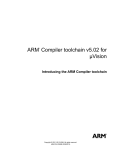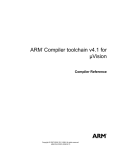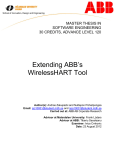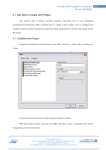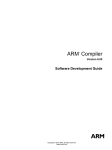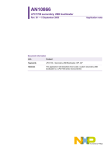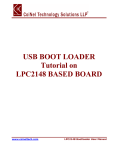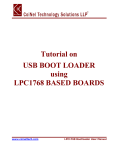Download Introducing the ARM Compiler toolchain
Transcript
ARM Compiler toolchain v4.1 for µVision ® Introducing the ARM Compiler toolchain Copyright © 2011 ARM. All rights reserved. ARM DUI 0592A (ID061811) ARM Compiler toolchain v4.1 for µVision Introducing the ARM Compiler toolchain Copyright © 2011 ARM. All rights reserved. Release Information The following changes have been made to this book. Change History Date Issue Confidentiality Change June 2011 A Non-Confidential Release for ARM Compiler toolchain v4.1 for µVision Proprietary Notice Words and logos marked with or are registered trademarks or trademarks of ARM in the EU and other countries, except as otherwise stated below in this proprietary notice. Other brands and names mentioned herein may be the trademarks of their respective owners. Neither the whole nor any part of the information contained in, or the product described in, this document may be adapted or reproduced in any material form except with the prior written permission of the copyright holder. The product described in this document is subject to continuous developments and improvements. All particulars of the product and its use contained in this document are given by ARM in good faith. However, all warranties implied or expressed, including but not limited to implied warranties of merchantability, or fitness for purpose, are excluded. This document is intended only to assist the reader in the use of the product. ARM shall not be liable for any loss or damage arising from the use of any information in this document, or any error or omission in such information, or any incorrect use of the product. Where the term ARM is used it means “ARM or any of its subsidiaries as appropriate”. Confidentiality Status This document is Non-Confidential. The right to use, copy and disclose this document may be subject to license restrictions in accordance with the terms of the agreement entered into by ARM and the party that ARM delivered this document to. Product Status The information in this document is final, that is for a developed product. Web Address http://www.arm.com ARM DUI 0592A ID061811 Copyright © 2011 ARM. All rights reserved. Non-Confidential ii Contents ARM Compiler toolchain v4.1 for µVision Introducing the ARM Compiler toolchain Chapter 1 Chapter 2 Conventions and feedback Overview of the ARM Compiler toolchain 2.1 2.2 2.3 2.4 2.5 2.6 2.7 2.8 2.9 2.10 2.11 2.12 2.13 2.14 2.15 2.16 2.17 2.18 2.19 Chapter 3 Creating an application 3.1 3.2 3.3 ARM DUI 0592A ID061811 About the ARM Compiler toolchain .......................................................................... 2-3 Host platform support for ARM Compiler toolchain ................................................. 2-5 About the toolchain documentation ......................................................................... 2-6 Licensed features of the toolchain ........................................................................... 2-8 Standards compliance in the toolchain .................................................................... 2-9 Compliance with the ABI for the ARM Architecture (Base Standard) .................... 2-10 Toolchain environment variables ........................................................................... 2-12 ARM architectures supported by the toolchain ...................................................... 2-14 Toolchain support on 64-bit host platforms ............................................................ 2-15 Using special characters on the compilation tools command-line ......................... 2-16 Compilation tools command-line option rules ........................................................ 2-17 About ordering the compilation tools command-line options ................................. 2-18 Autocompletion of compilation tools command-line option .................................... 2-19 Using a text file to specify command-line options .................................................. 2-20 Portability of source files between hosts ................................................................ 2-22 TMP environment variable for temporary file directories ....................................... 2-23 Specifying command-line options with an environment variable ........................... 2-24 Specifying Cygwin paths in compilation tools on Windows ................................... 2-25 Further reading ...................................................................................................... 2-26 Using the compilation tools ...................................................................................... 3-2 Using the compiler ................................................................................................... 3-3 Using the linker ........................................................................................................ 3-5 Copyright © 2011 ARM. All rights reserved. Non-Confidential iii Contents 3.4 3.5 ARM DUI 0592A ID061811 Using the assembler ................................................................................................ 3-6 Using the fromelf image converter ........................................................................... 3-7 Copyright © 2011 ARM. All rights reserved. Non-Confidential iv Chapter 1 Conventions and feedback The following describes the typographical conventions and how to give feedback: Typographical conventions The following typographical conventions are used: monospace Denotes text that can be entered at the keyboard, such as commands, file and program names, and source code. monospace Denotes a permitted abbreviation for a command or option. The underlined text can be entered instead of the full command or option name. monospace italic Denotes arguments to commands and functions where the argument is to be replaced by a specific value. monospace bold Denotes language keywords when used outside example code. italic Highlights important notes, introduces special terminology, denotes internal cross-references, and citations. bold Highlights interface elements, such as menu names. Also used for emphasis in descriptive lists, where appropriate, and for ARM® processor signal names. Feedback on this product If you have any comments and suggestions about this product, contact your supplier and give: • ARM DUI 0592A ID061811 your name and company Copyright © 2011 ARM. All rights reserved. Non-Confidential 1-1 Conventions and feedback • the serial number of the product • details of the release you are using • details of the platform you are using, such as the hardware platform, operating system type and version • a small standalone sample of code that reproduces the problem • a clear explanation of what you expected to happen, and what actually happened • the commands you used, including any command-line options • sample output illustrating the problem • the version string of the tools, including the version number and build numbers. Feedback on content If you have comments on content then send an e-mail to [email protected]. Give: • the title • the number, ARM DUI 0592A • if viewing online, the topic names to which your comments apply • if viewing a PDF version of a document, the page numbers to which your comments apply • a concise explanation of your comments. ARM also welcomes general suggestions for additions and improvements. ARM periodically provides updates and corrections to its documentation on the ARM Information Center, together with knowledge articles and Frequently Asked Questions (FAQs). Other information • ARM Product Manuals, http://www.keil.com/support/man_arm.htm • Keil Support Knowledgebase, http://www.keil.com/support/knowledgebase.asp • Keil Product Support, http://www.keil.com/support/ • ARM Glossary, http://infocenter.arm.com/help/topic/com.arm.doc.aeg0014-/index.html. ARM DUI 0592A ID061811 Copyright © 2011 ARM. All rights reserved. Non-Confidential 1-2 Chapter 2 Overview of the ARM Compiler toolchain The following topics provide general information about the ARM Compiler toolchain: Tasks • Using special characters on the compilation tools command-line on page 2-16 • Using a text file to specify command-line options on page 2-20 • Specifying command-line options with an environment variable on page 2-24 • Specifying Cygwin paths in compilation tools on Windows on page 2-25. Concepts • About the ARM Compiler toolchain on page 2-3 • About the toolchain documentation on page 2-6 • Licensed features of the toolchain on page 2-8 • Standards compliance in the toolchain on page 2-9 • Compliance with the ABI for the ARM Architecture (Base Standard) on page 2-10 • ARM architectures supported by the toolchain on page 2-14 • Toolchain support on 64-bit host platforms on page 2-15 • Compilation tools command-line option rules on page 2-17 • About ordering the compilation tools command-line options on page 2-18 • Autocompletion of compilation tools command-line option on page 2-19 • Portability of source files between hosts on page 2-22 • TMP environment variable for temporary file directories on page 2-23 Reference • Host platform support for ARM Compiler toolchain on page 2-5 • Toolchain environment variables on page 2-12 ARM DUI 0592A ID061811 Copyright © 2011 ARM. All rights reserved. Non-Confidential 2-1 Overview of the ARM Compiler toolchain • ARM DUI 0592A ID061811 Further reading on page 2-26. Copyright © 2011 ARM. All rights reserved. Non-Confidential 2-2 Overview of the ARM Compiler toolchain 2.1 About the ARM Compiler toolchain The ARM Compiler toolchain enables you to build applications for the ARM family of processors from C, C++, or ARM assembly language source. The toolchain comprises: armcc The ARM and Thumb® compiler. This compiles your C and C++ code. It supports inline and embedded assemblers. armasm The ARM and Thumb assembler. This assembles ARM and Thumb assembly language sources. armlink The linker. This combines the contents of one or more object files with selected parts of one or more object libraries to produce an executable program. armar The librarian. This enables sets of ELF format object files to be collected together and maintained in archives or libraries. You can pass such a library or archive to the linker in place of several ELF files. You can also use the archive for distribution to a third party for further application development. fromelf The image conversion utility. This can also generate textual information about the input image, such as disassembly and its code and data size. C++ libraries The ARM C++ libraries provide: • helper functions when compiling C++ • additional C++ functions not supported by the Rogue Wave library. C libraries The ARM C libraries provide: • an implementation of the library features as defined in the C and C++ standards • extensions specific to the compiler, such as _fisatty(), __heapstats(), and __heapvalid() • common nonstandard extensions to many C libraries. • POSIX extended functionality • functions standardized by POSIX. C micro-libraries The ARM C micro-library (Microlib) provides a highly optimized set of functions. These functions are for use with deeply embedded applications that have to fit into extremely small amounts of memory. Rogue Wave C++ library The Rogue Wave library provides an implementation of the standard C++ library. 2.1.1 Supporting software You can debug the output from the toolchain with any debugger that is compatible with the ELF, DWARF 2, and DWARF 3 specifications. Updates and patches to the toolchain are available from the ARM web site as they become available. 2.1.2 See also Concepts • Host platform support for ARM Compiler toolchain on page 2-5 ARM DUI 0592A ID061811 Copyright © 2011 ARM. All rights reserved. Non-Confidential 2-3 Overview of the ARM Compiler toolchain • • • • • • Licensed features of the toolchain on page 2-8 Standards compliance in the toolchain on page 2-9 Compliance with the ABI for the ARM Architecture (Base Standard) on page 2-10. ARM architectures supported by the toolchain on page 2-14. Toolchain support on 64-bit host platforms on page 2-15. Further reading on page 2-26. Using the Compiler: • Chapter 2 Overview of the compiler. Using the Assembler: • Chapter 2 Overview of the Assembler. Using the Linker: • Chapter 2 Overview of the linker. Using ARM® C and C++ Libraries and Floating Point Support: • Chapter 2 The ARM C and C++ libraries • Chapter 3 The ARM C micro-library. Creating Static Software Libraries with armar: • Chapter 2 Overview of the ARM Librarian. Using the fromelf Image Converter: • Chapter 2 Overview of the fromelf image converter. Other information • ARM website, http://www.arm.com. ARM DUI 0592A ID061811 Copyright © 2011 ARM. All rights reserved. Non-Confidential 2-4 Overview of the ARM Compiler toolchain 2.2 Host platform support for ARM Compiler toolchain Except where stated, the ARM Compiler toolchain supports both 32-bit and 64-bit versions of the following OS platforms: 2.2.1 • Windows 7 Enterprise Edition • Windows 7 Professional Edition • Windows XP Professional SP3 (32-bit only) • Windows Server 2003 • Windows Server 2008 R2 See also Tasks • Specifying Cygwin paths in compilation tools on Windows on page 2-25. Concepts • About the ARM Compiler toolchain on page 2-3. ARM DUI 0592A ID061811 Copyright © 2011 ARM. All rights reserved. Non-Confidential 2-5 Overview of the ARM Compiler toolchain 2.3 About the toolchain documentation The toolchain documentation comprises: Introducing the ARM® Compiler toolchain (ARM DUI 0592) - this document This document gives an overview of the toolchain and features. Using the Compiler (ARM DUI 0375) This document describes how to use the various features of the compiler, armcc. Compiler Reference (ARM DUI 0376) This document provides reference information for the various features of the compiler, armcc. It also provides a detailed description of each compiler command-line option. Using ARM® C and C++ Libraries and Floating-Point Support (ARM DUI 0378) This document describes the features of the ARM C and C++ libraries, and how to use them. It also describes the floating-point support of the libraries. ARM® C and C++ Libraries and Floating-Point Support Reference (ARM DUI 0589) This document provides reference information for the various features of the ARM C and C++ libraries. Using the Assembler (ARM DUI 0379) This document describes how to use the various features of the assembler, armasm. Assembler Reference (ARM DUI 0588) This document provides reference information for the various features of the assembler, armasm. It also provides a detailed description of each assembler command-line option. Using the Linker (ARM DUI 0377) This document describes how to use the various features of the linker, armlink. Linker Reference (ARM DUI 0458) This document provides reference information for the various features of the linker, armlink. It also provides a detailed description of each linker command-line option. Creating Static Software Libraries with armar (ARM DUI 0590) This document describes how to use the various features of the librarian, armar. It also provides a detailed description of each armar command-line option. Using the fromelf Image Converter (ARM DUI 0459) This document describes how to use the various features of the ELF image converter, fromelf. It also provides a detailed description of each fromelf command-line option. Errors and Warning Reference (ARM DUI 0591) This document describes the errors and warnings that might be generated by each of the build tools in ARM Compiler v4.1. ARM DUI 0592A ID061811 Copyright © 2011 ARM. All rights reserved. Non-Confidential 2-6 Overview of the ARM Compiler toolchain Migration and Compatibility (ARM DUI 0593) This document describes the differences you must be aware of in the ARM Compiler toolchain v4.1 for µVision, when migrating your software from earlier toolchain versions, such as ARM RVCT v4.0 for µVision. ARM DUI 0592A ID061811 Copyright © 2011 ARM. All rights reserved. Non-Confidential 2-7 Overview of the ARM Compiler toolchain 2.4 Licensed features of the toolchain The toolchain requires a toolchain license. If you purchased the toolchain with another ARM product, see the Getting Started document of that product for details of the licenses that are included. Licensing of the ARM development tools for µVision is controlled by the Keil licensing system, see Keil Product Licensing, http://www.keil.com/license/ for details. ARM DUI 0592A ID061811 Copyright © 2011 ARM. All rights reserved. Non-Confidential 2-8 Overview of the ARM Compiler toolchain 2.5 Standards compliance in the toolchain The toolchain conforms to the following standards. In each case, the level of compliance is noted: ar armar produces, and armlink consumes, UNIX-style object code archives. armar can list and extract most ar-format object code archives, and armlink can use an ar-format archive created by another archive utility providing it contains a symbol table member. DWARF 3 DWARF 3 debug tables (DWARF Debugging Standard Version 3) are supported by the toolchain. DWARF 2 DWARF 2 debug tables are supported by the toolchain, and by ELF DWARF 2 compatible debuggers from ARM. ISO C The compiler accepts ISO C 1990 and 1999 source as input. ISO C++ The compiler accepts ISO C++ 2003 source as input. ELF The toolchain produces relocatable and executable files in ELF format. The fromelf utility can translate ELF files into other formats. Note The DWARF 2 and DWARF 3 standard is ambiguous in some areas such as debug frame data. This means that there is no guarantee that third-party debuggers can consume the DWARF produced by ARM code generation tools or that an ARM debugger can consume the DWARF produced by third-party tools. 2.5.1 See also Concepts • Compliance with the ABI for the ARM Architecture (Base Standard) on page 2-10. Using the Compiler: • Source language modes of the compiler on page 2-3. Other information ARM DUI 0592A ID061811 • The DWARF Debugging Standard, http://dwarfstd.org/ • International Organization for Standardization, http://www.iso.org/iso/home.htm. Copyright © 2011 ARM. All rights reserved. Non-Confidential 2-9 Overview of the ARM Compiler toolchain 2.6 Compliance with the ABI for the ARM Architecture (Base Standard) The Application Binary Interface (ABI) for the ARM Architecture (Base Standard) (BSABI) is a collection of standards. Some of these standards are open. Some are specific to the ARM architecture. They regulate the inter-operation of binary code and development tools in ARM architecture-based execution environments. By conforming to this standard, objects produced by the toolchain can work together with object libraries from different producers. The BSABI consists of a family of specifications including: AADWARF DWARF for the ARM Architecture, http://infocenter.arm.com/help/topic/com.arm.doc.ihi0040-/index.html. This ABI uses DWARF 3 standard to govern the exchange of debugging data between object producers and debuggers. ARM DUI 0592A ID061811 AAELF ELF for the ARM Architecture, http://infocenter.arm.com/help/topic/com.arm.doc.ihi0044-/index.html. Builds on the generic ELF standard to govern the exchange of linkable and executable files between producers and consumers. AAPCS Procedure Call Standard for the ARM Architecture, http://infocenter.arm.com/help/topic/com.arm.doc.ihi0042-/index.html. Governs the exchange of control and data between functions at runtime. There is a variant of the AAPCS for each of the major execution environment types supported by the toolchain. BPABI Base Platform ABI for the ARM Architecture, http://infocenter.arm.com/help/topic/com.arm.doc.ihi0037-/index.html. Governs the format and content of executable and shared object files generated by static linkers. Supports platform-specific executable files using post linking. Provides a base standard that is used to derive a platform ABI. CLIBABI C Library ABI for the ARM Architecture, http://infocenter.arm.com/help/topic/com.arm.doc.ihi0039-/index.html. Defines an ABI to the C library. CPPABI C++ ABI for the ARM Architecture, http://infocenter.arm.com/help/topic/com.arm.doc.ihi0041-/index.html. Builds on the generic C++ ABI (originally developed for IA-64) to govern interworking between independent C++ compilers. DBGOVL Support for Debugging Overlay Programs, http://infocenter.arm.com/help/topic/com.arm.doc.ihi0049-/index.html. Defines an extension to the ABI for the ARM Architecture to support debugging overlaid programs. EHABI Exception Handling ABI for the ARM Architecture, http://infocenter.arm.com/help/topic/com.arm.doc.ihi0038-/index.html. Defines both the language-independent and C++-specific aspects of how exceptions are thrown and handled. RTABI Run-time ABI for the ARM Architecture, http://infocenter.arm.com/help/topic/com.arm.doc.ihi0043-/index.html. Governs what independently produced objects can assume of their execution environments by way of floating-point and compiler helper function support. Copyright © 2011 ARM. All rights reserved. Non-Confidential 2-10 Overview of the ARM Compiler toolchain If you are upgrading to ARM Compiler v4.1 for µVision from a previous toolchain release, ensure that you are using the most recent versions of the ARM specifications. 2.6.1 See also Other information ARM DUI 0592A ID061811 • Application Binary Interface for the ARM Architecture Introduction and downloads, http://infocenter.arm.com/help/topic/com.arm.doc.ihi0036-/index.html • Addenda to, and Errata in, the ABI for the ARM Architecture, http://infocenter.arm.com/help/topic/com.arm.doc.ihi0045-/index.html • Differences between v1 and v2 of the ABI for the ARM Architecture, http://infocenter.arm.com/help/topic/com.arm.doc.ihi0047-/index.html • ABI for the ARM Architecture Advisory Note: SP must be 8-byte aligned on entry to AAPCS-conforming functions, http://infocenter.arm.com/help/topic/com.arm.doc.ihi0046-/index.html. Copyright © 2011 ARM. All rights reserved. Non-Confidential 2-11 Overview of the ARM Compiler toolchain 2.7 Toolchain environment variables The ARM Compiler toolchain does not require environment variables to be set. However, there are situations where you might want to set environment variables. For example, if you want to specify additional command-line options for armcc, but you do not want to modify your build scripts, then you can specify the options using ARMCCnn_CCOPT. The environment variables used by the toolchain are: Table 2-1 Environment variables used by the toolchain Environment variable a Setting ARMROOT Your installation directory root (install_directory). This documentation assumes that install_directory is C:\Keil\ARM. ARMCCnn_ASMOPT An optional environment variable to define additional assembler options that are to be used outside your regular makefile. The options listed appear before any options specified for the armasm command in the makefile. Therefore, any options specified in the makefile might override the options listed in this environment variable. ARMCCnn_CCOPT An optional environment variable to define additional compiler options that are to be used outside your regular makefile. The options listed appear before any options specified for the armcc command in the makefile. Therefore, any options specified in the makefile might override the options listed in this environment variable. ARMCCnn_FROMELFOPT An optional environment variable to define additional fromelf image converter options that are to be used outside your regular makefile. The options listed appear before any options specified for the fromelf command in the makefile. Therefore, any options specified in the makefile might override the options listed in this environment variable. ARMCCnn_LINKOPT An optional environment variable to define additional linker options that are to be used outside your regular makefile. The options listed appear before any options specified for the armlink command in the makefile. Therefore, any options specified in the makefile might override the options listed in this environment variable. ARMCCnnINC The default system include path. That is, the path used to search for header filenames enclosed in angle-brackets. The compiler option -J overrides this environment variable. The default location of the compiler include files is: install_directory\RV31\INC ARMCCnnLIB The default location of the ARM standard C and C++ library files: install_directory\RV31\LIB The compiler option --libpath overrides this environment variable. Note If you include a path separator at the end of the path, the linker searches that directory and the subdirectories. So for install_directory\RV31\LIB the linker searches: LIB LIB\armlib LIB\cpplib ARMINC ARM DUI 0592A ID061811 Used only if you do not specify the compiler option -J and ARMCCnnINC is either not set or is empty. See the description of ARMCCnnINC for more information. Copyright © 2011 ARM. All rights reserved. Non-Confidential 2-12 Overview of the ARM Compiler toolchain Table 2-1 Environment variables used by the toolchain (continued) Environment variable a Setting ARMLIB Used only if you do not specify the compiler option --libpath and ARMCCnnLIB is either not set or is empty. See the description of ARMCCnnLIB for more information. CYGPATH The location of the cygpath.exe file on your system in Cygwin path format. For example: C:/cygwin/bin/cygpath.exe You must set this if you want to specify paths in Cygwin format for the compilation tools. Used on Windows platforms to specify the directory to be used for temporary files. If TMP is not defined, or if it is set to the name of a directory that does not exist, temporary files are created in the current working directory. TMP a. Replace nn with the version of the toolchain you are using. For example, ARMCC41INC if you are using ARM Compiler toolchain v4.1. 2.7.1 See also Concepts • TMP environment variable for temporary file directories on page 2-23 • Specifying command-line options with an environment variable on page 2-24 • Specifying Cygwin paths in compilation tools on Windows on page 2-25. Using the Assembler: • Chapter 2 Overview of the Assembler. Using the Compiler: • Chapter 2 Overview of the compiler. Using the Linker: • Chapter 2 Overview of the linker. Using ARM® C and C++ Libraries and Floating Point Support: • Chapter 2 The ARM C and C++ libraries. Using the fromelf Image Converter: • Chapter 2 Overview of the fromelf image converter. Creating Static Software Libraries with armar: • Chapter 2 Overview of the ARM Librarian. Reference Assembler Reference: • Chapter 2 Assembler command line options. Compiler Reference: • Chapter 3 Compiler Command-line Options. Linker Reference: • Chapter 2 Linker command-line options. Using the fromelf Image Converter: • Chapter 4 fromelf command reference. ARM DUI 0592A ID061811 Copyright © 2011 ARM. All rights reserved. Non-Confidential 2-13 Overview of the ARM Compiler toolchain 2.8 ARM architectures supported by the toolchain The toolchain includes support for all ARM architectures from ARMv4™ onwards that are currently supported by ARM. All architectures before ARMv4 are obsolete and are no longer supported. You can specify a target processor or architecture to take advantage of extra features specific to the selected processor or architecture. To do this, use the following command-line options: • --cpu=name • --fpu=name. You can specify the startup instruction set, ARM or Thumb, with the --arm or --thumb command-line options. Also, you can force an ARM-only instruction set with the --arm_only option. The compilation tools provide support for mixing ARM and Thumb code. This is known as interworking and enables branching between ARM code and Thumb code. 2.8.1 See also Tasks Using the Compiler: • Selecting the target CPU at compile time on page 5-8. Reference Compiler Reference: • --arm on page 3-11 • --arm_only on page 3-11 • --cpu=name on page 3-20 • --fpu=name on page 3-44 • --thumb on page 3-90. Assembler Reference: • --arm on page 2-6 • --arm_only on page 2-6 • --cpu=name on page 2-8 • --fpu=name on page 2-13 • --thumb on page 2-23. Linker Reference: • --arm_only on page 2-9 • --cpu=name on page 2-27 • --fpu=name on page 2-57. ARM DUI 0592A ID061811 Copyright © 2011 ARM. All rights reserved. Non-Confidential 2-14 Overview of the ARM Compiler toolchain 2.9 Toolchain support on 64-bit host platforms Although the toolchain is supported on certain 64-bit platforms, the tools are 32-bit applications. This limits the virtual address space and file size available to the tools. If these limits are exceeded, armlink reports an error message to indicate that there is not enough memory. This might cause confusion because sufficient physical memory is available but the application cannot access it. 2.9.1 See also Concepts • About the ARM Compiler toolchain on page 2-3. ARM DUI 0592A ID061811 Copyright © 2011 ARM. All rights reserved. Non-Confidential 2-15 Overview of the ARM Compiler toolchain 2.10 Using special characters on the compilation tools command-line You can use special characters to select multiple symbolic names in some compilation tools command arguments: • the wildcard character * can be used to match any name • the wildcard character ? can be used to match any single character. If you are using a special character on Unix platforms, you must enclose the options in quotes to prevent the shell expanding the selection. For example, enter ’*,~*.*’ instead of *,~*.*. Note The armar command-line options must be preceded by a -. This is different from some earlier versions of armar, and from some third-party archivers. 2.10.1 See also Reference Using the Assembler: • Assembler command line syntax on page 7-2 • Assembler commands listed in groups on page 7-3. Using the Compiler: • Compiler command-line syntax on page 3-3 • Compiler command-line options listed by group on page 3-4. Using the Linker: • Linker command-line syntax on page 2-3 • Linker command-line options listed in groups on page 2-4. Creating Static Software Libraries with armar: • armar command-line syntax on page 2-4 • armar command-line options listed in groups on page 2-5. Using the fromelf Image Converter: • fromelf command-line syntax on page 2-6 • fromelf command-line options listed in groups on page 2-7. ARM DUI 0592A ID061811 Copyright © 2011 ARM. All rights reserved. Non-Confidential 2-16 Overview of the ARM Compiler toolchain 2.11 Compilation tools command-line option rules You can control many aspects of the compilation tools operation with command-line options. The following rules apply, depending on the type of option: Single-letter options All single-letter options, including single-letter options with arguments, are preceded by a single dash -. You can use a space between the option and the argument, or the argument can immediately follow the option. For example: -J directory -Jdirectory Keyword options All keyword options, including keyword options with arguments, are preceded by a double dash --. An = or space character is required between the option and the argument. For example: --depend=file.d --depend file.d Compilation tools options that contain non-leading - or _ can use either of these characters. For example, --force_new_nothrow is the same as --force-new-nothrow. To compile files with names starting with a dash, use the POSIX option -- to specify that all subsequent arguments are treated as filenames, not as command switches. For example, to compile a file named -ifile_1, use: armcc -c -- -ifile_1 In some Unix shells, you might have to include quotes when using arguments to some command-line options, for example: --keep='s.o(vect)' 2.11.1 See also Reference Using the Assembler: • Assembler command line syntax on page 7-2 • Assembler commands listed in groups on page 7-3. Using the Compiler: • Compiler command-line syntax on page 3-3 • Compiler command-line options listed by group on page 3-4. Using the Linker: • Linker command-line syntax on page 2-3 • Linker command-line options listed in groups on page 2-4. Creating Static Software Libraries with armar: • armar command-line syntax on page 2-4 • armar command-line options listed in groups on page 2-5. Using the fromelf Image Converter: • fromelf command-line syntax on page 2-6 • fromelf command-line options listed in groups on page 2-7. ARM DUI 0592A ID061811 Copyright © 2011 ARM. All rights reserved. Non-Confidential 2-17 Overview of the ARM Compiler toolchain 2.12 About ordering the compilation tools command-line options In general, command-line options can appear in any order. However, the effects of some options depend on how they are combined with other related options. Where options override other options on the same command line, the options that appear closer to the end of the command-line take precedence. Where an option does not follow this rule, this is noted in the description for that option. Use the --show_cmdline option to see how the command line is processed. The commands are shown normalized. 2.12.1 See also Reference Compiler Reference: • --show_cmdline on page 3-85. Assembler Reference: • --show_cmdline on page 2-22. Linker Reference: • --show_cmdline on page 2-112. Using the fromelf Image Converter: • --show_cmdline on page 4-47. Creating Static Software Libraries with armar: • --show_cmdline on page 6-28. ARM DUI 0592A ID061811 Copyright © 2011 ARM. All rights reserved. Non-Confidential 2-18 Overview of the ARM Compiler toolchain 2.13 Autocompletion of compilation tools command-line option You can specify a shortened version of a command-line option with the autocompletion feature. To use the autocompletion feature, insert a full stop (.) after the characters to be autocompleted. The following rules apply to the autocompletion feature: • you must separate arguments from the full stop by an equals (=) character or a space character • you cannot use autocompletion for the arguments to an option • you must include sufficient characters to make the autocompleted option unique. For example, use --diag_su.=223 to specify --diag_suppress=223 on the command line. Specifying --diag.=223 is not valid, because --diag. does not identify a single unique command-line option. 2.13.1 See also Reference Using the Assembler: • Assembler commands listed in groups on page 7-3. Using the Compiler: • Compiler command-line options listed by group on page 3-4. Using the Linker: • Linker command-line options listed in groups on page 2-4. Creating Static Software Libraries with armar: • armar command-line options listed in groups on page 2-5. Using the fromelf Image Converter: • fromelf command-line options listed in groups on page 2-7. ARM DUI 0592A ID061811 Copyright © 2011 ARM. All rights reserved. Non-Confidential 2-19 Overview of the ARM Compiler toolchain 2.14 Using a text file to specify command-line options Some operating systems restrict the length of the command line. You can either: • specify options that extend beyond this limit by including them in a text file • place all of your command-line options in a text file. To use a text file to specify command-line options: 1. Create a text file containing the required command-line options. The options must be specified on a single line. For example: --debug --cpu=ARM926EJ-S 2. Use the --via command-line option to specify the file location containing the required options. For example: armcc --via myoptions.txt You can use any filename extension, or no filename extension. 2.14.1 Priority of command-line options when using them in a text file The compiler reads the command-line options from the specified file and combines them with any additional options you have specified on the command-line. The priority given to a command-line option depends on: • the command-line option • the position of the --via option on the command-line. To see the priority of the options, specify the --show_cmdline option. For example, if armcc.txt contains the options --debug --cpu=ARM926EJ-S: • armcc -c --show_cmdline --cpu=ARM7TDMI --via=armcc.txt hello.c [armcc --show_cmdline --debug -c --cpu=ARM926EJ-S hello.c] In this case, --cpu=ARM7TDMI is not used because --cpu=ARM926EJ-S is the last instance of --cpu on the command-line. • armcc --via=armcc.via -c --show_cmdline --cpu=ARM7TDMI hello.c [armcc --show_cmdline --debug -c hello.c] In this case, --cpu=ARM926EJ-S is not used because --cpu=ARM7TDMI is the last instance of --cpu on the command-line. In addition, --cpu=ARM7TDMI is not shown in the output, because this is the default option for --cpu. 2.14.2 See also Reference Assembler Reference: • --show_cmdline on page 2-22 • --via=file on page 2-24. Compiler Reference: • --show_cmdline on page 3-85 • --via=filename on page 3-95 • Appendix B Via File Syntax. Linker Reference: • --show_cmdline on page 2-112 • --via=file on page 2-145. ARM DUI 0592A ID061811 Copyright © 2011 ARM. All rights reserved. Non-Confidential 2-20 Overview of the ARM Compiler toolchain Creating Static Software Libraries with armar: • --show_cmdline on page 6-28 • --via=file on page 6-35. Using the fromelf Image Converter: • --show_cmdline on page 4-47 • --via=file on page 4-53. ARM DUI 0592A ID061811 Copyright © 2011 ARM. All rights reserved. Non-Confidential 2-21 Overview of the ARM Compiler toolchain 2.15 Portability of source files between hosts To assist portability of source files between hosts, use the following guidelines: 2.15.1 • Ensure that filenames do not contain spaces. If you have to use path names or filenames containing spaces, enclose the path and filename in double (") or single (') quotes. • Make embedded path names relative rather than absolute. • Use forward slashes (/) in embedded path names, not backslashes (\). See also Concepts • ARM DUI 0592A ID061811 Chapter 2 Overview of the ARM Compiler toolchain. Copyright © 2011 ARM. All rights reserved. Non-Confidential 2-22 Overview of the ARM Compiler toolchain 2.16 TMP environment variable for temporary file directories The compilation tools use the environment variable TMP to specify the directory to be used for temporary files. If TMP is not defined, or if it is set to the name of a directory that does not exist, temporary files are created in the current working directory. TMP is typically set up by a system administrator. However, it is permissible for you to change it. 2.16.1 See also Concepts • Chapter 2 Overview of the ARM Compiler toolchain. Reference • ARM DUI 0592A ID061811 Toolchain environment variables on page 2-12. Copyright © 2011 ARM. All rights reserved. Non-Confidential 2-23 Overview of the ARM Compiler toolchain 2.17 Specifying command-line options with an environment variable You can specify command-line options by setting the value of a tool-specific environment variable: • ARMCCnn_ASMOPT for the assembler • ARMCCnn_CCOPT for the compiler • ARMCCnn_FROMELFOPT for the fromelf image converter • ARMCCnn_LINKOPT for the linker. The syntax is identical to the command-line syntax. The compilation tool reads the value of the environment variable and inserts it at the front of the command string. This means that you can override options specified in the environment variable by arguments on the command-line. 2.17.1 See also Reference • ARM DUI 0592A ID061811 Toolchain environment variables on page 2-12. Copyright © 2011 ARM. All rights reserved. Non-Confidential 2-24 Overview of the ARM Compiler toolchain 2.18 Specifying Cygwin paths in compilation tools on Windows By default on Windows, the compilation tools require path names to be in the Windows DOS format, for example, C:\myfiles. If you want to use Cygwin path names, then set the CYGPATH environment variable to the location of the cygpath.exe file on your system. For example: set CYGPATH=C:/cygwin/bin/cygpath.exe You can now specify file locations in the compilation tools command-line options using the Cygwin path format. The paths are translated by cygpath.exe. For example, to compile the file /cygdrive/h/main.c, enter the command: armcc -c --debug /cygdrive/h/main.c You can still specify paths that start with: • a drive letter, for example C:\ or C:/ • a UNC, for example, \\computer. ARM Compiler tools do not translate these paths because the paths are already in a form that Windows understands. 2.18.1 See also Reference • Toolchain environment variables on page 2-12. Assembler Reference: • Chapter 2 Assembler command line options. Compiler Reference: • Chapter 3 Compiler Command-line Options. Linker Reference: • Chapter 2 Linker command-line options. Creating Static Software Libraries with armar: • Chapter 6 armar command reference. Using the fromelf Image Converter: • ARM DUI 0592A ID061811 Chapter 4 fromelf command reference. Copyright © 2011 ARM. All rights reserved. Non-Confidential 2-25 Overview of the ARM Compiler toolchain 2.19 Further reading Additional information on developing code for the ARM family of processors is available from both ARM and third parties. 2.19.1 ARM publications ARM periodically provides updates and corrections to its documentation. See ARM Infocenter, http://infocenter.arm.com/help/index.jsp for current errata sheets and addenda, and the ARM Frequently Asked Questions (FAQs). For full information about the base standard, software interfaces, and standards supported by ARM, see Application Binary Interface (ABI) for the ARM Architecture, http://infocenter.arm.com/help/topic/com.arm.doc.subset.swdev.abi/index.html. In addition, see the following documentation for specific information relating to ARM products: • ARM Architecture Reference Manuals, http://infocenter.arm.com/help/topic/com.arm.doc.subset.arch.reference/index.html • Cortex-R series processors, http://infocenter.arm.com/help/topic/com.arm.doc.set.cortexr/index.html • Cortex-M series processors, http://infocenter.arm.com/help/topic/com.arm.doc.set.cortexm/index.html • ARM9 processors, http://infocenter.arm.com/help/topic/com.arm.doc.set.arm9/index.html • ARM7 processors, http://infocenter.arm.com/help/topic/com.arm.doc.set.arm7/index.html • Vector floating-point coprocessors, http://infocenter.arm.com/help/topic/com.arm.doc.set.vfp/index.html. 2.19.2 Other publications This ARM Compiler tools documentation is not intended to be an introduction to the C or C++ programming languages. It does not try to teach programming in C or C++, and it is not a reference manual for the C or C++ standards. Other publications provide general information about programming. The following publications describe the C++ language: • ISO/IEC 14882:2003, C++ Standard. • Stroustrup, B., The C++ Programming Language (3rd edition, 1997). Addison-Wesley Publishing Company, Reading, Massachusetts. ISBN 0-201-88954-4. The following publications provide general C++ programming information: • Stroustrup, B., The Design and Evolution of C++ (1994). Addison-Wesley Publishing Company, Reading, Massachusetts. ISBN 0-201-54330-3. This book explains how C++ evolved from its first design to the language in use today. • Vandevoorde, D and Josuttis, N.M. C++ Templates: The Complete Guide (2003). Addison-Wesley Publishing Company, Reading, Massachusetts. ISBN 0-201-73484-2. • Meyers, S., Effective C++ (1992). Addison-Wesley Publishing Company, Reading, Massachusetts. ISBN 0-201-56364-9. This provides short, specific, guidelines for effective C++ development. ARM DUI 0592A ID061811 Copyright © 2011 ARM. All rights reserved. Non-Confidential 2-26 Overview of the ARM Compiler toolchain • Meyers, S., More Effective C++ (2nd edition, 1997). Addison-Wesley Publishing Company, Reading, Massachusetts. ISBN 0-201-92488-9. The following publications provide general C programming information: • ISO/IEC 9899:1999, C Standard. The standard is available from national standards bodies (for example, AFNOR in France, ANSI in the USA). • Kernighan, B.W. and Ritchie, D.M., The C Programming Language (2nd edition, 1988). Prentice-Hall, Englewood Cliffs, NJ, USA. ISBN 0-13-110362-8. This book is co-authored by the original designer and implementer of the C language, and is updated to cover the essentials of ANSI C. • Harbison, S.P. and Steele, G.L., A C Reference Manual (5th edition, 2002). Prentice-Hall, Englewood Cliffs, NJ, USA. ISBN 0-13-089592-X. This is a very thorough reference guide to C, including useful information on ANSI C. • Plauger, P., The Standard C Library (1991). Prentice-Hall, Englewood Cliffs, NJ, USA. ISBN 0-13-131509-9. This is a comprehensive treatment of ANSI and ISO standards for the C Library. • Koenig, A., C Traps and Pitfalls, Addison-Wesley (1989), Reading, Mass. ISBN 0-201-17928-8. This explains how to avoid the most common traps in C programming. It provides informative reading at all levels of competence in C. See The DWARF Debugging Standard web site, http://www.dwarfstd.org for the latest information about the Debug With Arbitrary Record Format (DWARF) debug table standards and ELF specifications. The following publications provide information about the European Telecommunications Standards Institute (ETSI) basic operations: • ETSI Recommendation G.191: Software tools for speech and audio coding standardization • ITU-T Software Tool Library 2005 User's manual, included as part of ETSI Recommendation G.191 • ETSI Recommendation G723.1: Dual rate speech coder for multimedia communications transmitting at 5.3 and 6.3 kbit/s • ETSI Recommendation G.729: Coding of speech at 8 kbit/s using conjugate-structure algebraic-code-excited linear prediction (CS-ACELP). These publications are all available from the telecommunications bureau of the International Telecommunication Union (ITU) web site, http://www.itu.int. Publications providing information about Texas Instruments compiler intrinsics are available from Texas Instruments web site, http://www.ti.com. ARM DUI 0592A ID061811 Copyright © 2011 ARM. All rights reserved. Non-Confidential 2-27 Chapter 3 Creating an application The following topics describe how to create an application using the toolchain: Tasks • Using the compilation tools on page 3-2 • Using the compiler on page 3-3 • Using the linker on page 3-5 • Using the assembler on page 3-6 • Using the fromelf image converter on page 3-7. ARM DUI 0592A ID061811 Copyright © 2011 ARM. All rights reserved. Non-Confidential 3-1 Creating an application 3.1 Using the compilation tools A typical application development might involve the following: • C/C++ source code for the main application (armcc) • assembly source code for near-hardware components (armasm), such as interrupt service routines • linking all objects together to generate an image (armlink) • converting an image to flash format in plain binary, Intel Hex, and Motorola-S formats (fromelf). The following figure shows how the compilation tools are used for the development of a typical application. armcc fromelf armlink code C/C++ ARM and Thumb .c .o data debug code data armasm Plain binary Intel Hex Motorola-S code Assembly code .s Source code .o debug data debug Image Object code Flash format Figure 3-1 A typical tool usage flow diagram 3.1.1 See also Tasks • Using the compiler on page 3-3 • Using the linker on page 3-5 • Using the assembler on page 3-6 • Using the fromelf image converter on page 3-7. ARM DUI 0592A ID061811 Copyright © 2011 ARM. All rights reserved. Non-Confidential 3-2 Creating an application 3.2 Using the compiler The compiler, armcc, can compile C and C++ source code into ARM and Thumb code. Typically, you invoke the compiler as follows: armcc [options] ifile_1 ... ifile_n You can specify one or more input files. 3.2.1 Compiling example To compile the C++ example source file shapes.cpp: 1. Compile the C++ file shapes.cpp with the following command: armcc --cpp --debug -c -O1 shapes.cpp -o shapes.o The following options are commonly used: -c Tells the compiler to compile only, and not link. -cpp Tells the compiler that the source is C++. --debug Tells the compiler to add debug tables for source-level debugging. -O1 Tells the compiler to generate code with restricted optimizations applied to give a satisfactory debug view with good code density and performance. -o filename Tells the compiler to create an object file with the specified filename. Note Be aware that --arm is the default compiler option. 2. Link the file: armlink shapes.o --info totals -o shapes.axf 3. Use an ELF, DWARF 2, and DWARF 3 compatible debugger to load and run the image. See the readme.txt file that accompanies the example for more information. 3.2.2 Compiling for ARM code The following compiler options generate ARM code: --arm Tells the compiler to generate ARM code in preference to Thumb code. However, #pragma thumb overrides this option. This is the default compiler option. --arm_only 3.2.3 Forces the compiler to generate only ARM code. The compiler behaves as if Thumb is absent from the target architecture. Any #pragma thumb declarations are ignored. Compiling for Thumb code To build a Thumb version use: armcc --thumb ... ARM DUI 0592A ID061811 Copyright © 2011 ARM. All rights reserved. Non-Confidential 3-3 Creating an application where: Tells the compiler to generate Thumb code in preference to ARM code. However, #pragma arm overrides this option. --thumb 3.2.4 See also Tasks • Using the linker on page 3-5. Using the Compiler: • Chapter 3 Getting started with the Compiler. Reference Compiler Reference: • Command-line options on page 3-6 • --arm on page 3-11 • --arm_only on page 3-11 • -c on page 3-17 • --debug, --no_debug on page 3-24 • -g on page 3-47 • -o filename on page 3-69 • -Onum on page 3-71 • --thumb on page 3-90 • #pragma arm on page 5-47 • #pragma thumb on page 5-60. ARM DUI 0592A ID061811 Copyright © 2011 ARM. All rights reserved. Non-Confidential 3-4 Creating an application 3.3 Using the linker The linker combines the contents of one or more object files with selected parts of one or more object libraries to produce an image or object file. Typically, you invoke the linker as follows: armlink [options] file_1 ... file_n 3.3.1 Linking example To link the object file shapes.o, use the command: armlink shapes.o --info totals -o shapes.axf where: 3.3.2 -o Specifies the output file as shapes.axf. --info totals Tells the linker to display totals of the Code and Data sizes for input objects and libraries. See also Tasks Using the Linker: • Chapter 3 Linking models supported by armlink. Reference Linker Reference: • ARM DUI 0592A ID061811 Chapter 2 Linker command-line options. Copyright © 2011 ARM. All rights reserved. Non-Confidential 3-5 Creating an application 3.4 Using the assembler The basic syntax to use the assembler (armasm) is: armasm [options] inputfile For example, to assemble the code in a file called myfile.s, and to include debugging information in the resulting object file, type: armasm --debug myfile.s This generates an object file called myfile.o. 3.4.1 Building an example from assembler source To build an assembler program, for example word.s: 1. Assemble the source file using the command: armasm --debug word.s 2. Link the file using the command: armlink word.o -o word.axf 3. Use an ELF, DWARF 2, and DWARF 3 compatible debugger to load and run the image. Step through the program and examine the registers to see how they change. 3.4.2 See also Tasks Using the Assembler: • Assembler command line syntax on page 7-2. Reference Assembler Reference: • ARM DUI 0592A ID061811 Chapter 2 Assembler command line options. Copyright © 2011 ARM. All rights reserved. Non-Confidential 3-6 Creating an application 3.5 Using the fromelf image converter The features of the fromelf image converter utility include: • converting an executable image in ELF executable format to other file formats • controlling debug information in output files • disassembling either an ELF image or an ELF object file • protecting intellectual property (IP) in images and objects that are delivered to third parties • printing information about an ELF image or an ELF object file. 3.5.1 Examples of using fromelf The following examples show how to use fromelf: fromelf --text -c -s --output=outfile.lst infile.axf Creates a plain text output file that contains the disassembled code and the symbol table of an ELF image. fromelf --bin --16x2 --output=outfile.bin infile.axf Creates two files in binary format (outfile0.bin and outfile1.bin) for a target system with a memory configuration of a 16-bit memory width in two banks. The output files in the last example are suitable for writing directly to 16-bit Flash device. 3.5.2 See also Tasks Using the fromelf Image Converter: • Chapter 3 Using fromelf. Reference Using the fromelf Image Converter: • ARM DUI 0592A ID061811 Chapter 4 fromelf command reference. Copyright © 2011 ARM. All rights reserved. Non-Confidential 3-7








































